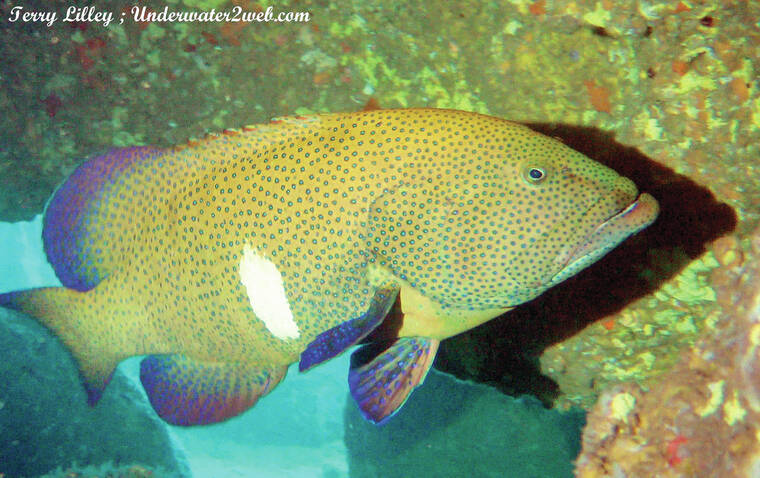For thousands of years butterfly fish have protected our coral reefs by feeding on dead and dying corals, which makes room for new corals to grow. The Hawaiian name for many of the butterfly fish species is kikakapu, which means “forbidden.”
In old Hawai‘i, it was kapu to take a butterfly fish off the reef because the Hawaiians understood how important they were to the future of the marine ecosystem. But nowadays, we are losing a lot of our butterfly fish and this negative trend started way back in 1953.
Hawai‘i is so isolated in the middle of the sea that only certain fish species ever reached our shores and the large groupers were not one of them. We have very few large predatory fish here in Hawai‘i and almost no groupers and that is why we have so many butterfly fish and also moray eels.
In Tahiti, where big grouper are common there are far less butterfly fish and eels because grouper eat them. While scuba diving in Bora Bora, I shot video of a 20-inch long peacock grouper slowly moving over the reef and all of the smaller fish scattered so they would not be eaten. The prey evolved with the predators so there has been a balance produced of predator prey populations.
Here in Hawai‘i, our balance of predators and prey was dramatically changed when the state government brought in live peacock grouper (roi) from French Polynesia and let them go on the Hawaiian reefs in 1953. They said they did this to increase the large fish populations for the Hawaiians to eat, but what happened was a disaster.
The butterfly fish do not recognize the roi as a predator because they did not evolve together in Hawai‘i. When the roi goes up to a butterfly fish it has an easy meal because the smaller fish does not try to get away.
I even have video of small Hawaiian reef fish going right up to look at the face of a large peacock grouper and it just got swallowed instantly. Adding roi to our coral reefs is like adding giant saltwater crocodiles into Hanalei Bay, then wondering where all the people went down the road in a few years.
What can we do about the exploding population of roi on our reefs because eventually they will eat up all our butterfly fish and ruin the entire reef ecosystem?
We can catch them. We had a “roi roundup” spearfishing tournament at Anini Beach a few years back and the fishermen speared over 400 roi. The fish collected were used for organic fertilizer so they were converted to fresh vegetables to feed the community.
Roi are easy to spearfish and I personally speared over 400 roi in Hanalei Bay over a 10-year period of time. In 2014, I did a roi survey in Hanalei Bay and counted an average of 18 roi on a one hour scuba dive.
In 2022, I did the same survey area and counted two roi so a single person can make a difference. We know that an adult roi can eat over 200 reef fish in their lifetime so by spearing one roi you can save 200 native fish. Spearfishing is fun and you can spear just the fish you want and you don’t leave behind tangled fishing lines on the reef.
Fishery management is super important for the future of our coral reefs and spearfishing can make a huge positive difference for the future of our corals. If each person that likes to fish goes out and spears two roi, then they basically are protecting 400 native fish from being eaten.
Then they can spear a nice papio for dinner and they will be adding fish to the reef for future fishermen to catch.
Roi are a type of grouper and they are super good to eat but they may contain ciguatera, which is a type of natural fish poisoning so one must be careful about eating the fish. When I spear a roi, I eat one small bite then I wait for at least 10 hours to eat the rest of the fish. If it has any fish toxin in it you will have a mild stomach ache of which won’t be harmful. If you do not wish to eat the roi, use it in the garden for fertilizer and convert something negative to the environment into something positive.
You can see my full underwater movie about our invasive fish species here in Kaua‘i and the damage they are doing to our coral reefs up on my YouTube at Underwater2web. Since the state of Hawai‘i introduced the roi in the first place I feel it would be good for the state to pay spearfisher people at least $5 a roi to remove them from the reefs. If they did that, so many people would spear the roi that we could restore our butterfly fish populations and protect our fishery for the next generation to enjoy.
•••
Terry Lilley is a marine biologist living in Hanalei Kaua‘i and co-founder of Reef Guardians Hawai‘i, a nonprofit on a mission to provide education and resources to protect the coral reef. To donate to Reef Guardians Hawai‘i go to www.reefguardianshawaii.org.


